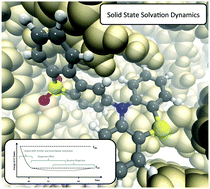The role of solid state solvation on the charge transfer state of a thermally activated delayed fluorescence emitter
Abstract
The influence of solid state solvation is crucial for understanding the device properties of 3rd generation organic light emitting diodes (OLEDs) based upon thermally activated delayed fluorescence (TADF), for which the native environment of the molecular emitter is an amorphous organic thin film. In this work we use quantum chemistry and molecular dynamics to demonstrate that the magnitude of static solid state solvation effects (SSSE) in a molecular excited state depends not only upon the dipole moment of the host, but also its rigidity and the dipole moment of the emitter in its electronic ground state. Subsequently, molecular dynamics is used to study recently observed time-dependent aspects of solvation in TADF emitters. In contrast to the previously proposed guest–host interactions, the origin of these dynamic effects is proposed to be associated with the dispersion of charge transfer (CT) decay times, which are strongly sensitive to structural fluctuations of the emitter. Our findings extend the present understanding of SSSE in the context of 3rd generation OLEDs based upon TADF, which may be exploited to develop new strategies for higher performing devices.



 Please wait while we load your content...
Please wait while we load your content...